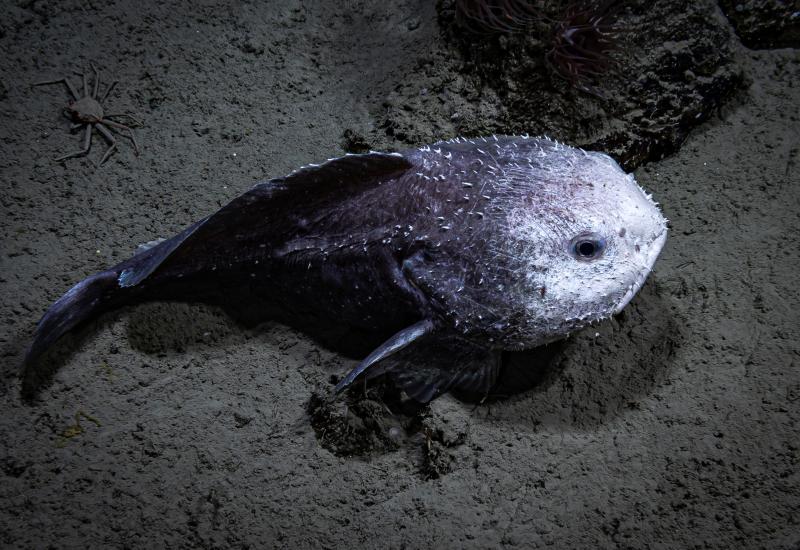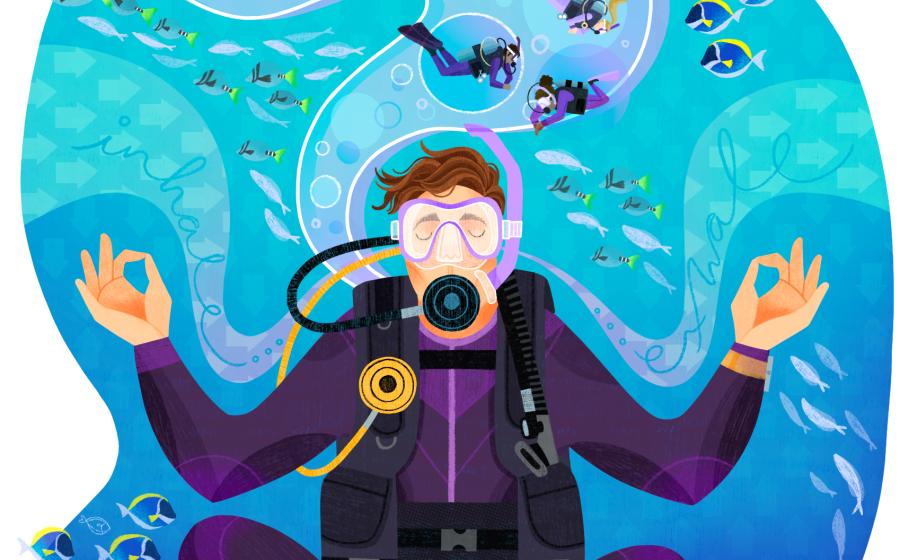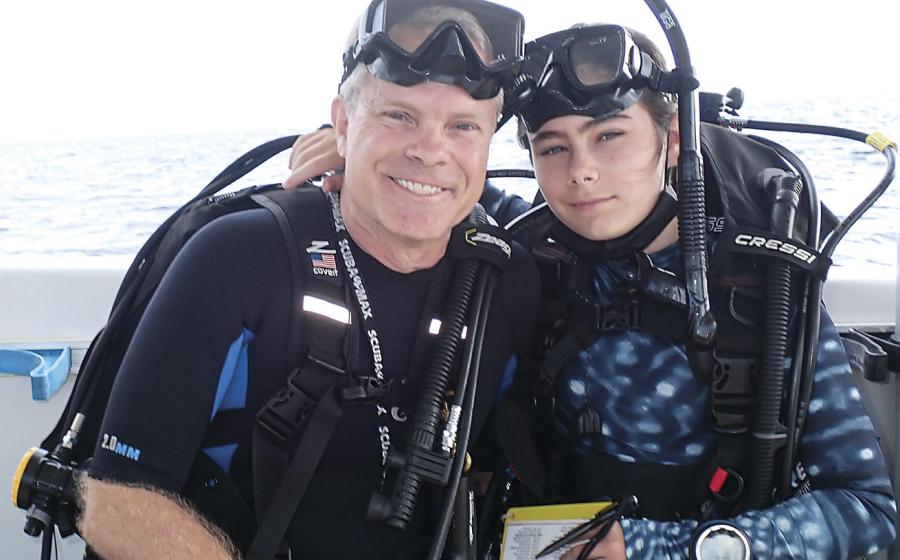Encounters: Good Neighbors
From the reef to the open ocean, some marine animals have found ways to ease the daily rigors of survival in the underwater world by joining forces. Symbiotic and commensal relationships sometimes create mutually beneficial relationships for wildly dissimilar creatures — much to the entertainment of divers.

Christopher Parsons
Pederson Shrimp and Corkscrew Anemones
Roatan
Neighborly symbiosis is standard operating procedure for many species on the protected reefs of Roatan, in Honduras’ Bay Islands. Especially the Pederson cleaner shrimp, which does double duty by developing separate relationships for its shelter and its food. These vibrant, translucent- and-purple shrimp make their home inside the tentacles of corkscrew anemones by developing a tolerance to their normally toxic sting. From here, they wave their long white antennae, broadcasting a symbiotic cleaning service to passing fish, which either hover above or lie down nearby to allow the shrimp to pick off parasites and dead-skin cells. The shrimp get a meal while the fish get a spa treatment — both leave happy.
>When to go Pederson cleaner shrimp can be spotted year-round on Roatan’s reefs. For the best conditions on the north-side sites, like the West End Wall and Half Moon Bay, visit during spring or summer. During winter, the southern reefs offer protection from winter swells.
>Operator With a waterfront location on Roatan’s north side, Tranquilseas Eco Lodge & Dive Center (tranquilseas.com) in Sandy Bay features five air-conditioned cabanas, each with a private deck, plus restaurant, bar and freshwater pool in a tropical setting.
>Price Tag Lodging/diving packages at Tranquilseas start at $1,918 for seven nights and 10 dives for two guests, double occupancy, or daily boat dives from $50.

Reinhard Dirscherl
Zebra crabs and fire urchins
Komodo
Indonesia, keep watch for the brilliant red fire urchin for a chance to spot its symbiotic stowaway, the distinctive and unusual zebra crab. This tiny crab — one of many commensal crabs throughout the Indo-Pacific — has sharp, toothlike ridges along the edge of its carapace, and black-and-white stripes across its body. It lives its entire life nestled within the potent spines of the fire urchin. Zebra crabs have even evolved specialized hooks on the ends of their back legs to help them hold tight to the spines. The urchins provide the crab protection, while the crabs likely graze on parasites and other particles that settle among the spines.
>When to go Divers can spot zebra crabs and fire urchins year-round in the reefs of Komodo. Overall, the diving is good here throughout the year, but the best sea conditions and visibility are generally found from November to January.
>Operator A traditional wooden phinisi vessel, the Arenui live-aboard (thearenui.com) serves 16 guests in eight staterooms with a private head, plus amenities including camera tables, a large dive deck, spa services, kayaks and more.
>Price Tag Eight- to 11-night itineraries, including meals, tendered diving and more, start at $3,680 per person.

Jones & Shimlock
Randall’s shrimp goby and snapping shrimp
Fiji
A famous example of mutualistic symbiosis can be spotted on the South Pacific seabeds of Fiji, where the Randall’s shrimp goby and its life partner, the snapping shrimp, make an entertaining odd couple in the rubble flats of Beqa Lagoon. The two share a burrow, and each has its own domestic chores, allowing them to fare far better together than either would on its own. The goby lacks the strength and stamina to maintain its own burrow, so it keeps watch just outside the hole, alerting the blind shrimp with a flick of its tail at the first sign of trouble. The shrimp’s poor eyesight makes it ill-prepared to spot oncoming danger, but its large claws are perfect for perpetually excavating sand from their cozy underground bunker.
>When to go Fiji’s Beqa Lagoon has fairly consistent dive conditions year-round, though they do fluctuate slightly according to the seasons. The dry season from June to October tends to have the best visibility but the coolest water temperatures. The water is warmest from January to March, but this is also storm season.
>Operator On tiny Beqa Island in the middle of the lagoon, Beqa Lagoon Resort (beqalagoonresort.com) features 25 air- conditioned bures (think private villa), set amid tropical grounds. The full-service on-site dive operator runs multiple boats daily
>Price Tag Beqa Lagoon Resort offers seven-night packages with air travel from Los Angeles, accommodations, meals, five two-tank boat dives and unlimited shore diving starting at $2,798 per person.

Jeffrey C. De Guzman
**Imperator Shrimp and Nudibranchs
**Philippines
The Imperator (also Imperial or Emperor) shrimp is a favorite subject among macro photographers in Coral Triangle hot spots like Anilao, Philippines. And that’s largely because this commensal critter has an odd habit of catching rides on some of the sea floor’s slowest denizens, the nudibranchs. These tiny shrimp are smaller than a fingernail, but its bright-red body and broad white markings help make it stand out. The shrimp rarely roams from its ride, instead making a living by feeding on the waste of its host. Look for them clinging around the gills of sea slugs like the Spanish dancer.
>When to go Imperator shrimp reside on Anilao’s reefs year-round. However, divers will want to avoid the summer months. July to October is monsoon season, which can affect the otherwise impeccable visibility.
>Operator The Atlantis Azores live-aboard (atlantishotel.com) — which visits Anilao October to November from Puerto Galera — has room for 16 divers in eight staterooms each with a private head, plus daily marinelife presentations, a hot tub, a large dive deck with camera tables and more.
>Price Tag A seven-night itinerary, including meals, tendered diving and more, starts at $2,795 per person.
From the reef to the open ocean, some marine animals have found ways to ease the daily rigors of survival in the underwater world by joining forces. Symbiotic and commensal relationships sometimes create mutually beneficial relationships for wildly dissimilar creatures — much to the entertainment of divers.










